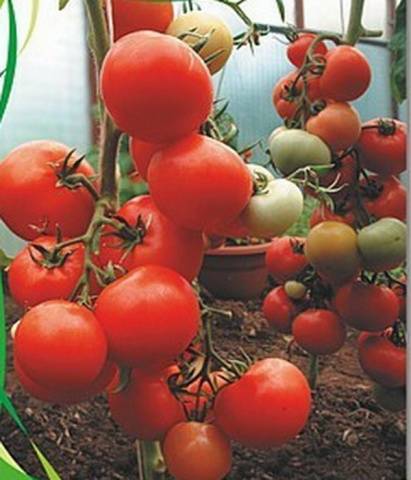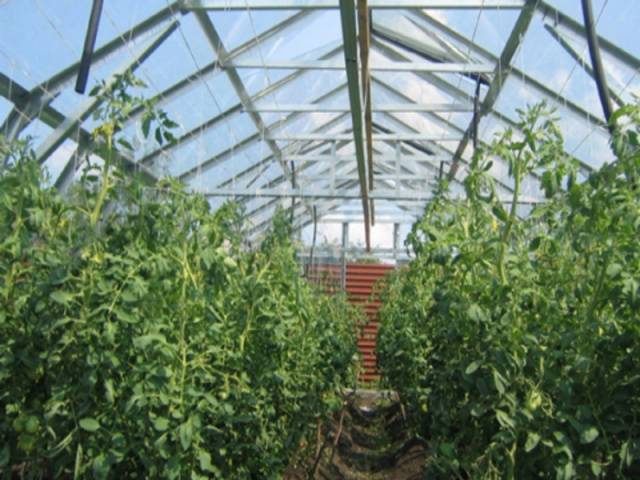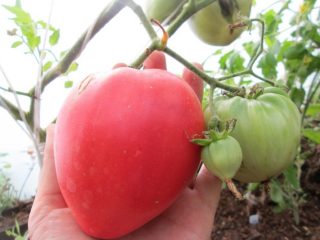Content
Sometimes the modest size of the plot does not allow the summer resident to “walk around” and plant all the varieties of vegetables he likes. The optimal way out is to plant indeterminate varieties of tomatoes, thanks to which you can significantly save space and grow more different crops.
Description of the variety
Tomato Kirzhach F1 is a hybrid of the first generation, the result of the work of breeders. It is an indeterminate variety with an average ripening period (105-115 days). Tomatoes are grown in greenhouses. Tomato variety Kirzhach F1 fully meets the characteristics of indeterminate varieties: a tall plant, very leafy.
Stems are strong, not prone to breaking off. The leaves are large and not strongly dissected. When growing tomatoes in a greenhouse, the top is usually pinched. The manufacturer recommends shaping the tomato into one stem. The first inflorescence appears above the 9-11 leaves.
Kirzhach F1 tomatoes ripen large and have a rounded shape. The peel is red in color, smooth and with a glossy shine (as in the photo). The tomato is distinguished by its fleshy pulp and pleasant taste. Perfect for fresh consumption. The Kirzhach F1 variety stands out for its stable yield. On average, up to 6 kg of fruit can be harvested from one bush.
Advantages of the indeterminate grade Kirzhach F1:
- long growing season. New fruits are constantly formed on the Kirzhach F1 tomato, right up to the first autumn frosts;
- tomato is resistant to top rot, fusarium, tobacco mosaic virus;
- there is a constant flow of air to the tied stems. Thanks to natural ventilation, Kirzhach tomatoes practically do not get sick with late blight, rot;
- high productivity in compact areas. Tomatoes are well preserved and transported.
When growing Kirzhach, some disadvantages should be noted:
- the need for arranging trellises, which is associated with both material and physical costs;
- you cannot collect seeds of the Kirzhach F1 variety for growing tomatoes in the future. Which, in principle, is typical for all hybrids;
- a tomato of this variety needs constant care in terms of forming a bush, removing stepsons and excess foliage, tying up the stems. If you do not remove shoots, then the greenhouse will turn into a solid green thicket.
Care rules
For growing tomatoes of the Kirzhach F1 variety, the seedling method is used. Depending on the climatic characteristics of the region, seeds are planted in late February or early March.
Seeds of the Kirzhach variety of proven producers usually do not need preliminary processing (information is indicated on the packages).
Germination stages
- Loose and nutritious soil (with the addition of sand and peat) is prepared in the boxes. You can also add wood ash or superphosphate to the soil.
- Tomato seeds of the Kirzhach F1 variety are spread on a moistened soil surface in even rows and sprinkled with a thin layer of earth (approximately 4-6 mm). The surface of the soil is sprayed with water. To prevent the soil from drying out, cover the box with plastic wrap or glass.
- It is recommended to place the container in a warm place (approximately 20-23˚C). As soon as the first sprouts of tomatoes appear, the film is removed and the boxes are placed in a lighted place. Containers should be kept in a warm, well-lit place, free of drafts.
- When a second pair of leaves appears on the sprouts of a Kirzhach tomato variety, it is necessary to feed.As a fertilizer, you can use a solution of a mixture of phosphorus, nitrogen, potassium, taken in equal parts. After a few days, you can plant Kirzhach tomato seedlings in separate pots. The sprouts must be taken carefully so as not to damage the tomatoes.
On the eve of planting Kirzhach seedlings in a greenhouse, it is necessary to harden the seedlings. To do this, two weeks earlier, the tomatoes are taken out into the open air. Of course, you shouldn't get carried away. Only on warm sunny days, the Kirzhach F1 tomato variety can stand outside for several hours. This procedure is especially important when planting seedlings in an unheated greenhouse.
It is advisable to start planting tomato seedlings in early May. To create favorable conditions in the greenhouse, it is advisable to renew the topsoil annually. To do this, clean river sand and humus are poured into the garden soil.
The holes are dug at a distance of 35-45 cm from each other. Wood ash or a tablespoon of superphosphate is added to each hole.
After transplanting, each seedling of the Kirzhach F1 tomato variety is tied to a support (stakes, twigs or trellis). Since the tomato grows very quickly, high supports are immediately installed. Form the tomato into one stem, carefully removing unnecessary processes. After three weeks, you can feed the tomatoes. Solutions of mineral mixtures (mainly phosphorus and potassium) are used as fertilizers. During this period, it is recommended to abandon the use of nitrogen fertilization, as it promotes the abundant growth of tomato greenery, which prevents the formation of ovaries.
Watering tomatoes
The Kirzhach variety does not welcome abundant watering. For these tomatoes, it is preferable to choose moderate soil moisture twice a week. But this mode depends on climatic characteristics. In a dry hot summer, it is necessary to water Kirzhach tomatoes more often. It is recommended to pour water at the root.
It is imperative to carry out regular loosening of the soil in order to remove the crust that impedes air exchange.
To provoke the appearance of new ovaries, you can pick Kirzhach tomatoes unripe. It is advisable to monitor the formation of deformed ovaries and immediately break them off.
Tomato pests and diseases
Kirzhach is highly resistant to many diseases. However, in greenhouse conditions, there is a possibility of the appearance of some diseases.
Late blight (fungal disease) is one of the most common diseases of tomatoes. High humidity in the greenhouse and cool temperatures can provoke the appearance of fungus. Disease affects tomatoes, leaves, stems. Symptoms appear as brown spots.
The complexity of the situation lies in the fact that it is no longer possible to completely cure the plant. Alternatively, you can contain or slow down the progression of the disease in order to have time to collect the tomatoes. Therefore, the main way to fight is prevention, which will prevent the onset of the disease or slow down its development:
- the soil in the greenhouse before planting seedlings is treated with a biological solution (Gamair, Alirin) in the proportion: a tablet for 10 liters of water;
- after planting the seedlings, the Kirzhach F1 tomatoes are sprayed with solutions of biological preparations (Gamair, Alirin) in the calculation of one tablet per liter of water;
- no sharp changes in air temperature (decrease) and humidity (increase) should be allowed in the greenhouse. If signs of illness appear, you must immediately reduce the number of waterings.
Of the greenhouse pests of tomatoes Kirzhach, it is especially worth highlighting slugs, since they can significantly reduce the yield of tomatoes. You can get rid of pests in various ways: chemical, agrotechnical and mechanical.
Agrotechnical ones involve loosening and digging the soil, weeding weeds and timely thinning of tomatoes.
Mechanical ones involve the use of traps (sheets of cardboard, pieces of burlap, boards).Install devices in the evening, and in the morning the pests are collected and destroyed. However, this method is considered ineffective, since slugs reappear after a short period of time.
Chemicals are considered to be more effective. Saturated salt solutions, a 10% solution of copper sulfate, a mixture of furnace ash, mustard, and red pepper are used. Processing must be carried out repeatedly.
Due to its high yield and unpretentiousness, the Kirzhach F1 tomato is becoming increasingly popular among gardeners. And disease resistance allows it to be grown in different regions.











